There is a sadness and quiet strength on the faces of the Mexican people this week, as they grapple to comprehend and overcome the oppression and destruction of a major earthquake. Unfortunately, Mexico has a long history of unjust hardship as it struggles for a better life. Nowhere is this better represented than in the art of the Mexican muralist movement.
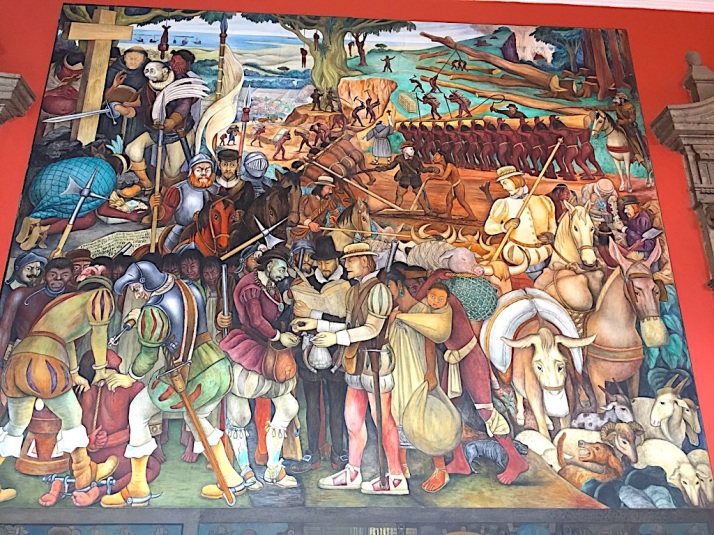
“The Arrival of Cortés”, by Diego Rivera (National Palace)
Following the Mexican revolution, the newborn government commissioned epic murals on walls of highly visible public buildings to communicate their progressive message, and educate the mostly illiterate masses about the history of Mexico. Thanks to the Mexican muralist movement, art was no longer the private possession of the rich, but free to view for all.
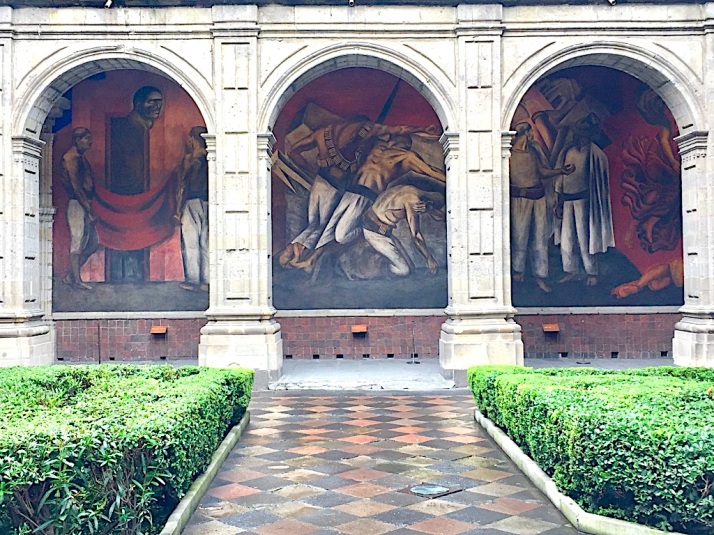
“The Trench” by José Orozco (College of San Ildefonso)
My own mural viewing began at the former college of San Ildefonso, the birthplace of the Mexican muralist movement. Here, murals fill the stairwells and walls of the three arcaded floors. Notably, twenty of the murals were painted by José Clemente Orozco. Orozco employed distorted human figures to emphasize human suffering and the horrors of war.

“Catharsis” by José Orozco (Palacio de Bellas Artes)
Orozco was the oldest and most complex of the Big Three (Los Tres Grandes). The other two “great ones” were David Alfaro Siqueiros, and the most famous Mexican artist of the 20th century Diego Rivera. To compare their works, I visited the Palacio de Bellas Artes, where representative murals by all three stood side-by-side across its elegant art deco walls.

“Man, Controller of the Universe” by Diego Rivera
The most recognizable of the Bellas Artes murals is Diego Rivera’s “Man, Controller of the Universe”, possibly his most famous work. In his hopeful and traditional painting style, Rivera depicts the emergence of man in control of a new scientific and industrial age.

“Torment and Apotheosis of Cuahtémoc” by David Siqueiros
David Siqueiros used sinewy human figures and a futuristic style in his Bellas Artes murals “New Democracy” and the“Torment and Apotheosis of Cuahtémoc”. Although the Big Three were all communists, Siqueiros was the most dedicated and radical.

Polyforum Siqueiros Exterior
To try to better understand Siqueiros’ message, I visited the Polyforum Siqueiros to see his most famous work, “The March of Humanity”. Considered the world’s largest mural, the interior and exterior of the 12-sided building is completely covered in a single unified piece of art.

“The March of Humanity” by David Siqueiros
A fusion of architecture, painting, and sculpture, the space inside the Polyforum, looked to me like a fun house under a giant circus tent. Amidst the bizarre psychedelic symbolism, Siqueiros shows humanity’s struggles and search for a better society.
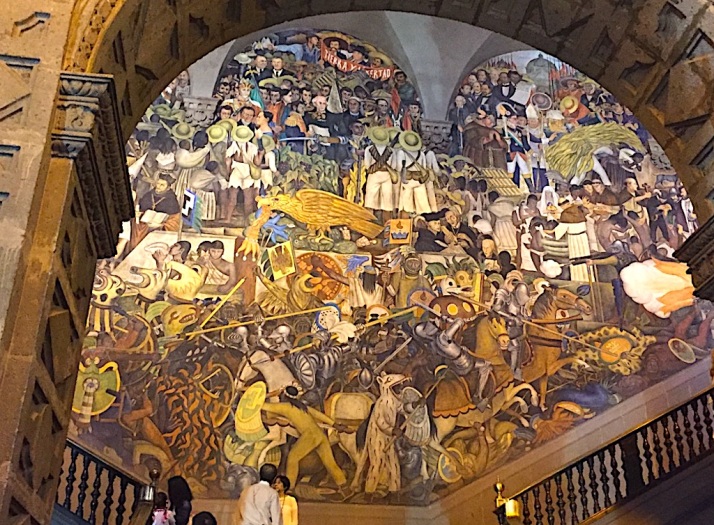
“Epic of the Mexican People” by Diego Rivera
Also depicting the hardships of the Mexican people and a hopefulness for the future, Diego Rivera expertly illustrated the history of Mexico in his murals. A prime example is his “Epic of the Mexican People” filling the stairwell of the National Palace.
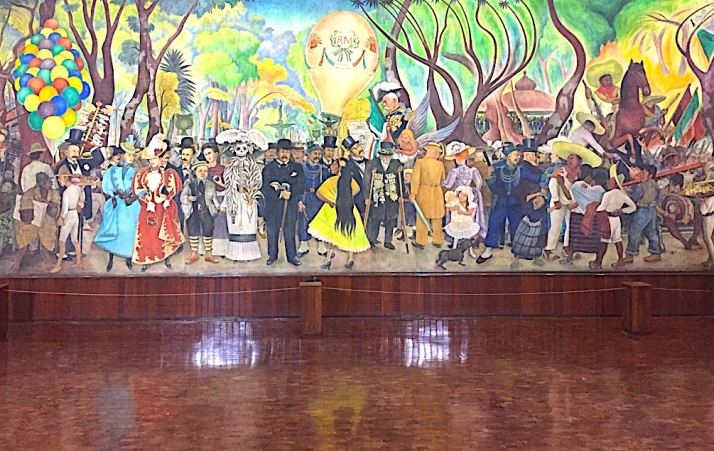
“Dream of a Sunday Afternoon in Alameda Central” by Diego Rivera
Nearby, in the Diego Rivera Mural Museum, Rivera includes hundreds of portraits from 400 years of Mexican history in his “Dream of a Sunday Afternoon in Alameda Central”. From Cortés to Rivera himself, the huge mural is a panoramic picture of key figures in Mexico’s history.
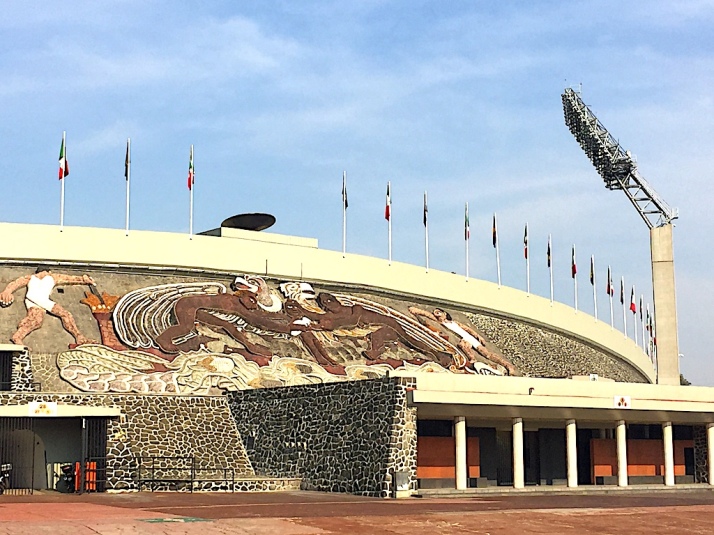
Diego Rivera’s unfinished mural on the 1968 Olympic Stadium
I concluded my tour of Mexico City’s murals at UNAM, the country’s most prestigious university. On campus, under the 1968 Olympic cauldron, Diego Rivera began his most ambitious mural. Intending to decorate the entire exterior of the stadium bowl, he was only able to complete the first panel.

UNAM Library, “A Historical Representation of the Culture” by Juan O’Gorman
Of all the murals that I found in Mexico City, my favorite is located just across the street from the Olympic Stadium. Completed entirely in a mosaic of naturally colored stones from around Mexico, the 10-story university library mural is the work of Juan O’Gorman.

UNAM Library Mural, Juan O’Gorman signature
Although not recognized as one of the Big Three, O’Gorman used the muralist medium to create his own narrative history of Mexico. From its pre-Hispanic roots through Spanish colonization and the modern age, this mighty mural, like the horrific events of this week’s major earthquake, capture Mexico’s long history of unjust hardship and its struggles for a better life.

Earthquake Volunteers, A Modern Mexican Mural

Those murals are a amazing – I love the Art Deco influence. Another reason to add Mexico City to my list of places to visit. It appears that none of these masterpieces were harmed by the earthquake?
LikeLiked by 1 person
The Mexican murals are so big and bold, and contain such interesting subject matter. I have not seen any reports of damage to the murals or the museums that house them. I have seen a lot of art deco design around Mexico City. Hopefully those structures were spared as well.
LikeLiked by 1 person
Possibly the greatest art movement of the modern world – so full of passion, colour, compassion and pride!
LikeLiked by 1 person
I cannot argue with your statement. Although I am not an art expert, I have been captivated by the 20th century murals of Mexico. In addition to your description, I find the historical subject matter educational and the symbolism intriguing. Thank you very much for your comment!
LikeLike
One word … WOW!
LikeLiked by 1 person
Coincidently, that is the one word I used too, only I said it about a hundred times.
LikeLike
Beautiful pictures. You really captured the murals, which even with the best camera I’d imagine is challenging. I was lucky to have seen a Diego Rivera mural in person while growing up outside of Detroit. He had been commissioned to do one for the Detroit Institute of Arts. – Marty
LikeLiked by 1 person
Thanks a lot, Marty. It is amazing what you can do with an iPhone these days. I read about Rivera’s Detroit mural project. His knack for capturing industrial culture made it one of his most successful murals. I am feeling spoiled for having the chance to see so many of his works here in Mexico City.
LikeLiked by 1 person
Wonderful article…love that you have seen so many of the murals. I hope to see more on my return visit. I love reading your articles–so informative. One day, I’ll sit down and have a binger going through them all.
LikeLiked by 1 person
Thank you, Tiffany. I am happy that you enjoyed the article and found it useful as you plan and dream about your upcoming trip back to Mexico.
LikeLike
So interesting. It’s great you were able to see so many different ones in different settings. I hadn’t realised there were so many of these murals in Mexico city, I’m glad they’re available for all to see!
LikeLiked by 1 person
Thank you, Kirstie. I found the collection of Mexico City murals to be beautiful and interesting. The historical subject matter was educational and the symbolism thought-provoking. As you say, the best thing about the murals were that they are all available for public enjoyment.
LikeLike
I love murals and I love Mexican art. I had a very influential painting teacher who had grown up in Mexico and used these murals to illustrate drama and emotion through the brushstroke. Wonderful post and photos of dramatic works!
Peta
LikeLiked by 1 person
Thank you, Peta. Your art teacher from Mexico was brilliant to use murals as a teaching tool. Besides illustrating drama and emotion through the brushstroke, they also seem to employ many varied artistic techniques and styles. My favorite Mexican murals portrayed so much activity and history that I could admire them for hours.
LikeLike